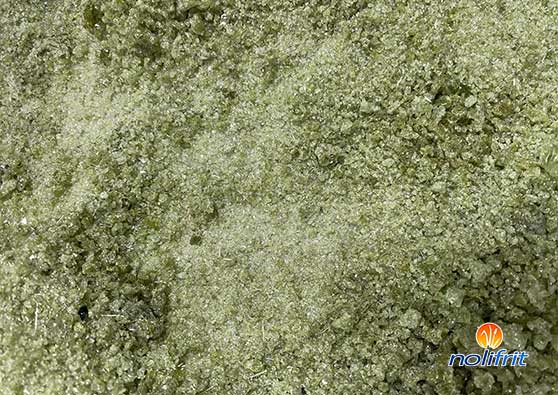Porcelain Enamel Frit: Properties of Enamel Ground Coat and Cover Coat
There are many varieties of enamel frit, such as enamel base glaze, enamel cover coat, cast iron frit, acid-resistant frit, etc. With the development and progress of the enamel industry, there are also enamel RTU powder and enamel electrostatic powder and other enamel products. This article mainly introduces the performance of the enamel melt and the use of precautions, hope to help enamel manufacturers, welcome to collect this article.

1.Enamel Ground Coat
The enamel ground coat is particularly important in enamel frit. Its key characteristic is strong adhesion, forming a firm chemical bond with the steel plate. When a 1-kilogram conical rod (with a cone tip shaped as a 5mm diameter sphere) is dropped freely from a height of 750mm onto the enamel surface, a fine mesh-like pattern indicates excellent quality, whereas blocky bare metal patches indicate poor quality.The surface quality of the ground coat should be fine, smooth, and free from defects such as pits, pinholes, boiling, shrinkage, or cracking. The ground coat'sresistance to firing and the number of firings it are extremely important. If the ground coat is properly applied and fired, but then subjected to one or more additional firings with the cover enamel, defects such as craze lines, mesh-like bubbles, or black spots may appear. These issues are caused by the ground coat’s insufficient firing resistance.A common solution is to use a combination of soft and hard enamel glazes, and to incorporate a certain amount of quartz powder or other grinding materials into the mixture.
2. Enamel Cover Coat
Cover coats are categorized into titanium cover coat, antimony cover coat, colored titanium cover enamel, colored base cover enamel, black cover coat, matte cover coat, etc.
Titanium cover coat has strong coloring power, that’s strong covering power. A porcelain layer thickness of 0.12–0.2 mm generally provides good coverage. The whiteness is above 85; polish is over 95 and can reach up to around 120. The enamel surface is delicate and smooth. The color tones of titanium cover enamel include bluish white and ivory. When the enamel layer exceeds 0.25 mm, it tends to peel off, especially at R corners, where cracks, craze lines, and shrinkage are likely to occur. When organic impurities are present, defects such as boiling points and spots may appear.
Colorful titanium cover coat offers even, pure color and good gloss, with examples including cream yellow, ivory, titanium pink, titanium gray, light titanium blue-green, and titanium green. However, the firing temperature must be properly controlled—temperature fluctuations will affect the color tone. Color differences may also occur between the first and second applications of cover coat. Other defects are the same as those found with white titanium white frit.Antimony cover coat has poor covering ability and usually requires a second application. Due to excessive antimony content, it has been phased out.
3. Transparent Frit
Transparent frit is usually mixed with pigments to make desired colors, commonly used for spray decoration. Nowadays it is widely used with various colored cover coat. Since the range of colored titanium frit is limited and cannot meet the demand for producing dozens or even tens of thousands of colors, pigments are added to transparent frit to meet production needs.Transparent frit is required to be transparent or semi-transparent so it does not interfere with the pigment's color development or cause discoloration. The surface should be smooth and fine, with a glossiness generally around 110. However, transparent frit has lower firing resistance than titanium cover frit and is typically fired at about 20°C lower. Over-firing can cause color degradation, reduced gloss, and poor surface quality.

4. Acid-Resistant Enamel Frit
Acid-resistant frit includes acid-resistant ground coat,acid-resistant cover coat, and acid-resistant transparent frit. Ordinary enamel frit is usually rated acid resistance grade B or C. Acid-resistant enamel comes in Grade A and Grade AA. A common test involves soaking in 10% citric acid for 15 minutes: if the surface shows no marks after rinsing and wiping, it's rated grade AA; if slight marks appear but can be wiped off with a finger, it's rated grade A; if the gloss is completely lost and the marks cannot be removed, it's rated grade B.
Industrial acid-resistant enamel frit have stricter standards, using boiling 30% sulfuric acid for several hours and measuring weight loss. Thus, the industrial acid resistance grade is even higher.
5. Pearlescent Enamel Frit
Pearlescent enamel frit is also considered a type of transparent frit. It has extremely high gloss, strong light refraction, and vibrant coloration. It is used to imitate antique finishes, copper, gold, silver, shimmering gold, and shimmering silver in spot enamel finishes.
Its firing temperature is relatively low, typically between 780–800°C. Excessively high temperatures can lead to loss of gloss and color fading. Metallic powders used to imitate gold, silver, or copper are not added during ball milling; instead, they are mixed in after the pearlescent enamel frit has been milled, then stirred and sieved before use.